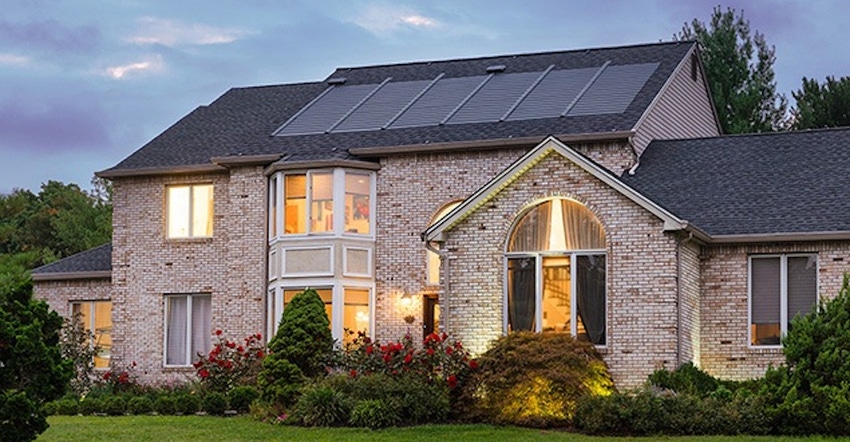3 Emerging Products That Align the Solar Market With Roofing
Building-integrated photovoltaics make installs more like traditional shingling than ever—but there’s more to navigate to find success with this offering.
May 11, 2023

Something unexpected happened at this year’s International Roofing Expo that speaks to the potential of a new market—one that industry experts say holds massive potential for roofing and exteriors companies.
For the first time, Tesla’s booth at the show allowed contractors to sign up to become certified installers of the company’s solar roofing product. Interest was off the charts, according to Ken Kelly, president of Florida-based Kelly Roofing, which is one of the first firms to install Tesla’s solar roofing system.
“I was absolutely shocked at how many people signed up for their training at that show,” Kelly said. “It goes to show that there’s absolutely an interest and a commitment to learn and do it.”
Tesla’s solar roof is just one of three major manufacturer offerings that are making it easier for roofers to claim a market that’s projected to grow five times larger over the next 10 years, according to the Solar Energy Industries Association’s forecast.
Kelly said it’s a pivotal time for roofing and exteriors companies to grab a share of this growing market—or risk seeding it to another industry.
“I’m glad to see that the new technology is putting us in the driver’s seat and not electricians,” he said.
The new technology he mentioned is generally known as building-integrated photovoltaics, or BIPV. Essentially, this group of products integrates photovoltaics—the solar technology that turns the sun’s energy into electricity—into roofing products and even the shingles themselves.
As the roofing market begins to cool amid economic headwinds, now is a smart time for roofers to diversify their offerings, said Mark Graham, NRCA’s vice president of technical services.
“With photovoltaics, (roofing contractors) can sell not only traditional roofing water tightness but also energy efficiency,” Graham said, “which for the right owner is a pretty attractive sell.”
How attractive? Kelly said that since his firm started offering Tesla solar roofs in 2020 it’s been the top-selling roofing system and the most profitable install.
“People really want it,” he said. “There’s an emotional connection to the sale of this product. They almost don’t care about the price.”
At least three manufacturers offer BIPV products. Here’s a look at these offerings—and how roofers can take advantage of them.
1. Tesla
The company’s solar roof is essentially a combination of steel and glass shingles. The glass tiles integrate the photovoltaic cells into the shingle and can produce 72 watts of electricity per shingle, according to the company’s website. Completed roofs look a bit like traditional tile roofs and offer the highest wind and fire ratings, the firm says, along with a Class 3 hail rating and a 25-year limited warranty.
“We’re talking about a really good roofing system,” Kelly said.
Kelly was among only a dozen roofing companies that offered the product. But in January 2023, that number had jumped to more than 85. As the company ramps up its training, Kelly said he expects that number to continue to grow quickly.
The product continues to evolve and simplify, Kelly said, making it easier for roofers to install it in a similar manner as traditional asphalt shingles.
2. GAF
The company’s Timberline Solar roofing system is made up of shingles that are warranted to withstand winds up to 130 mph, according to the GAF website. Unlike rack-mounted solar installations, this system doesn’t require drilling holes into the roof membrane and can be placed over existing shingles.
Kelly said the GAF system is much more like a standard rack-mounted solar kit that comes in 3.6-kilowatt systems, making it a simpler install. He said GAF sends its crews to tie the solar roofing systems into the home’s electrical panel, so roofers don’t have to worry about that part of the install.
“(GAF) simplified it,” he said. “It’s very easy to stock, order and install.”
The system debuted in 2022, and GAF says it offers training and support to those who want to start.
3. CertainTeed
The company’s Solstice Shingle system is its BIPV offering, using “high-efficiency monocrystalline silicon solar cells to capture and convert maximum solar energy,” according to the company’s website. The horizontal shingles produce a maximum of 70 watts of power each, the firm says, and are designed to be integrated with asphalt shingle roofs.
The system offers a 25-year power and workmanship limited warranty along with some of the highest wind, fire and hail ratings. This also includes a 10-year, 110 mph, limited wind warranty. It’s designed for fast installation by shingle roofing crews, according to CertainTeed, and can be installed directly on roof sheathing using standard deck screws. “It’s pretty straightforward,” said Graham, who’s gone through the training.
The CertainTeed system debuted at this year’s IRE show, making it one of the newest products on the market.
Tips and advice
Since these manufacturers offer extensive training and support for roofers who want to learn how to install BIPV products, Graham recommended choosing a manufacturer partner to be an important step for contractors entering the solar market.
Another key is to look at incentives that are available in the area. In fact, new incentives included in the federal Inflation Reduction Act of 2022 along with local, state and utility savings can reduce the cost anywhere from 30% to 50%. Graham recommended using the Database of State Incentives for Renewables and Efficiency to determine whether roofers are in a “solar friendly” state for such incentives.
Graham said navigating the many financing and incentives—and learning how to use them as a selling tool—is probably the biggest learning curve for selling solar.
“It seems like the business side is a bigger barrier than the install side,” he said. “(Many roofers) are used to saying, ‘This is the price of the roof.’ But with solar, contractors might have to deal with federal, state and local agencies.”
Along with those complications, Kelly said there’s also a hornet’s nest of regulatory hurdles that can make it challenging to complete installations.
“We need regulatory reform, and we need to unify the permitting process,” he said.
At the same time, Kelly said that contractors need to be prepared to be inundated with new leads and have a system to quickly weed out any “tire kickers” who won’t commit. His company offers remote demos and phone sales calls to determine which customers are serious about solar installs.
But all those caveats aside, Kelly and Graham said roofers who learn to navigate this new market stand to reap significant rewards.
“There’s going to be an investment, but it’ll be worth it,” Kelly said. “Right now, this market is about to catapult to new heights. And I would prefer that roofers … get in front of this, because it’s not something that’s just going to fall in our laps. We’re going to have to go in and make this happen.”
Read more about:
solar roofingAbout the Author(s)
You May Also Like




